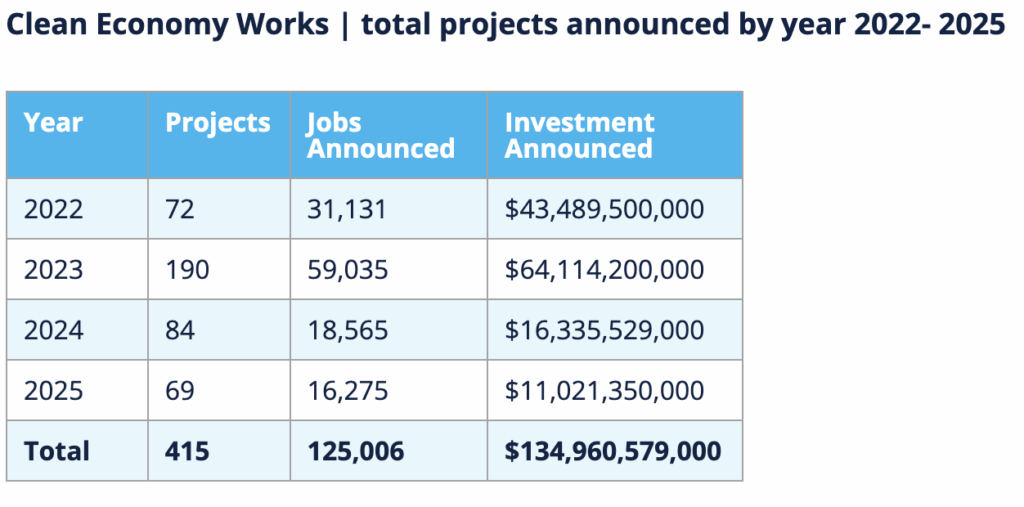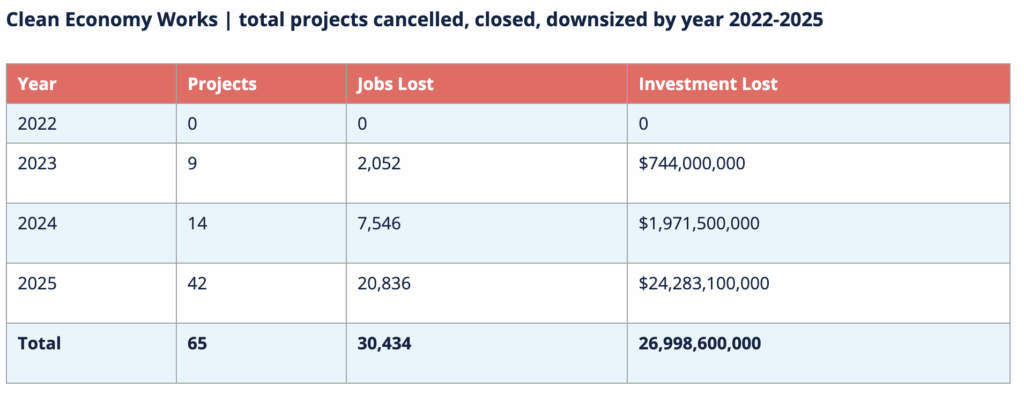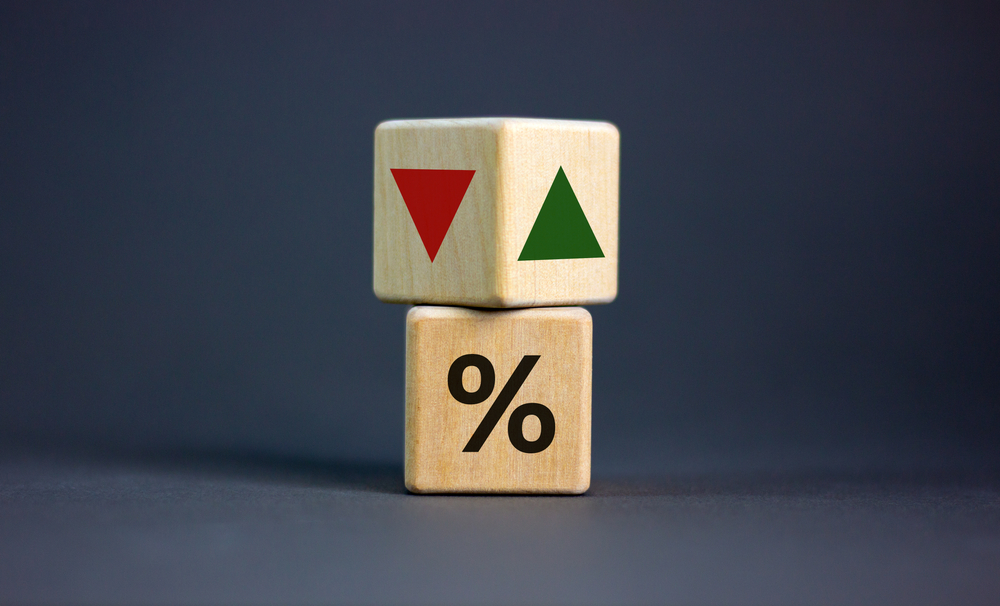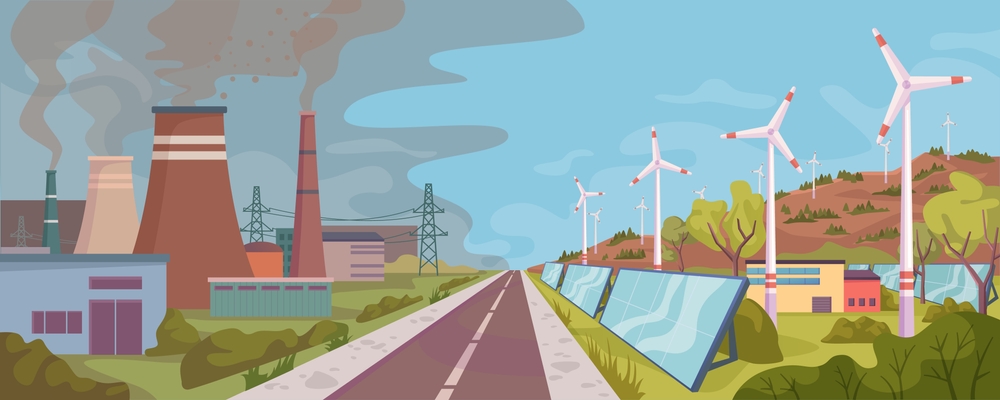
The good thing about knowing where you are is that it makes it easier to figure out where to go.
No one doubts that the Trump administration’s policies reduced clean energy investment, but now we can more clearly pinpoint what that means thanks to a new analysis by E2, a non-profit organization that seeks policies that are good for the economy and the environment.
E2’s report looks at the highs and lows of the last three years — the projects announced after passage of the Biden administration’s Inflation Reduction Act in 2022 and those canceled after the new administration took office.
Where We Are
It’s not all bad, but bad enough for E2 to conclude that the US is “destabilizing one of the nation’s fastest-growing industries, with ripple effects across supply chains, manufacturing hubs, and rural economic development.”
In August 2022, energy developers and manufacturers announced 415 major projects across 42 states and Puerto Rico, representing $135 billion and 125,000 planned jobs.
But 42 projects were cancelled or scaled back since the beginning of this year, a $24 billion investment loss that killed 28,800 jobs. Electric vehicles and batteries took the biggest hit (and also represented the biggest expected investment in 2022).


None of this is a big surprise. Cancellations of energy projects — from battery manufacturing plants to new electric vehicle models to low-income rooftop solar programs — have been in the news.
But here’s what’s really interesting.
Distributed energy — one subset of energy transition technologies — is thriving due to a counterforce. It’s hard to build centralized energy infrastructure (power plants, wind farms, transmission) quickly enough to meet growing energy demand. This opens the door for distributed energy projects because they can be installed much more quickly, and explains the growing interest data centers show in the resource.
Thus, the distributed energy industry finds itself in a strange period of headwinds and tailwinds.
Where We Are Going: One Tactic
Nonetheless, it’s been a tough period for distributed rooftop solar, which has counted heavily on tax incentives and grants. One way to offset this tailwind is to reduce project costs. The industry has been talking about cutting installation “soft” costs as a means to do so.
Like E2, Permit Power brought clarity to the discussion last week by publishing the numbers. The non-profit organization reported that soft costs make up an astonishing 78% of the cost of installing rooftop solar.
Fixing the problem isn’t impossible. Australia has done so. While a 7-kW solar system costs a median $28,000 in the US, the pricetag is $4,000 in Australia. And not surprisingly, one in three Australian households has rooftop solar. In the US, the number is fewer than one in ten.
Subscribe to the free, weekly Energy Changemakers Newsletter. Or if you’d like more of our news and analysis, join our community, starting at only $59.99/year.
What are soft costs in this context?
Permit Power describes them as largely the “delays associated with outdated and cumbersome approval processes, such as varying and convoluted permitting requirements across localities, differing requirements between plan reviewers and inspectors within the same jurisdiction, and unresponsive and bureaucratic utility interconnection processes.”
The report says that the US can nearly triple solar installations by 2040, if it revises its polices, including:
- Adopt instant permitting software or a qualified third-party permitting to issue instant permits for standard residential solar and battery projects.
- Use remote inspection protocols that allow code compliance to be verified through photos or video submissions for routine residential installations.
- Implement automatic utility interconnection approvals for qualifying residential systems that use smart inverters and meet established technical screens.
- Update outdated local government and utility requirements that mandate the installation of unnecessary and expensive hardware, and prevent the use of modern cost-saving technology.
That’s a lot of work, especially since much of it requires change at the local level. But at this point, it seems easier than getting federal tax incentives re-instituted.
So there are encouraging signs ahead for distributed energy. It offers a quick way to meet growing electric demand and is honing in on ways to reduce costs to overcome federal policy changes.
The Bigger Picture: Energy Innovation was Never Purely Technical
Long-term growth, however, requires an even bigger grasp of the forces moving the industry forward — and may take more of a cultural or social reckoning.
Economist Lynne Kiesling posted a fascinating blog this week on Substack that looks at the work by this year’s Nobel Prize winners in economics — Noel Mokyr, Philippe Aghion and Peter Howitt — and applies their ideas on sustained economic growth to the electricity sector.
Their frameworks provide “tools for thinking about how to facilitate innovation, manage disruption and sustain growth,” she writes. “Understanding how innovation drives growth helps us understand how to design policy so that the energy-transition era we are in the middle of creating can yield widespread prosperity and dynamism.”
Her blog compares today’s electricity transition to the Industrial Revolution and the rise of the steam engine, which vastly accelerated economic growth and led to the discovery of more and more ways to transform energy into work.
In what might be my new favorite phrase, she points out that even then, “energy innovation was never purely technical” but depended on a “dynamic system of discovery, displacement, entrepreneurship, competition, and institutions.”
“The current transition toward more low-carbon, distributed, and digital energy systems mirrors earlier transformations in both scale and significance,” she writes. “Like the shift from waterwheels to steam, it demands not only new technologies but new institutions, infrastructures and mental models.”
Right now, it may seem like those institutions and infrastructure are slow to grasp what I’d argue is the new mental model — grid decentralization. But the need for more electricity, a push for local energy and a desire to dampen electricity costs, suggest they will arrive, likely state by state, and hopefully soon.



